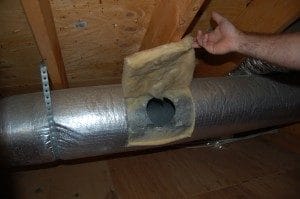If you are not in the building industry, You probably aren’t up to date on what building code is currently in effect. Right now we are building under the 2012 International Building code. You might think that it’s strange that we are using a code that is that is four years old, but that is how the code process works. A new one is written every three years and it takes about three years for it to get through the approval process and become the code that the building officials use when they inspect your house.
The Code
Some of the changes that were to the 2012 International code Virginia decided to have not apply to Virginians (like the requirement that all homes have fire suppression sprinklers), and there are other portions (like the requirement for Blower Door testing for houses and the Duct leakage testing for duct work) that Virginia has made optional. You can imagine that I was not entirely pleased with the optional part of the Blower Door testing and the duct testing requirement as I am a huge proponent of building energy efficiently, and building a tight home with tight duct work is the single best way to accomplish that.
Even though the duct testing is optional many contractors are finding the visual inspection of their duct work requirements prevents them from insulating the duct work as they are installing it and have opted instead for the Duct Leakage Test done by third party firms like ours. It would seem to be common sense to most people that ductwork should be as tight as possible since you are paying a fortune to heat and cool that precious conditioned air and then running it in ductwork that is probably in your attic or crawlspace which are not conditioned. I spend a lot of time doing Energy Audits on homes and often times that includes testing the home owner’s ductwork for leaks. Although most HVAC contractors are reputable installers, sometimes things can be overlooked or over the years, things may happen to the ductwork that causes it to leak and waste energy. The best way to avoid wasting money is to have your ductwork tested for air tightness when it is installed. Testing your duct system to insure that it is as tight as possible at the beginning of its life will save you a considerable amount of money every year that the unit is in operation.
Health Benefits

Another reason to make your ductwork tight is because tight ductwork is healthier for you. Gaps and holes in your system allow dirty, dusty, moldy air to enter your ductwork and leave a thick layer of allergy and asthma causing dust throughout your duct system. Think about it, if your ducts are dusty, how did that dust get there? All the air entering your duct system enters through a filter, so if you are having trouble with dust in your ducts, chances are you have some significant leaks somewhere where air is entering your system without first passing through a filter.
Just looking at duct work can’t tell you how it is going to perform and hiring a reputable firm doesn’t necessarily mean that the guy who happened to install your duct work did an adequate job of sealing. Testing is the only way to be sure of what you are paying for. Give GCI Energy Consultants a call if you have questions about your new house or your new duct work and we will set your mind at ease.
